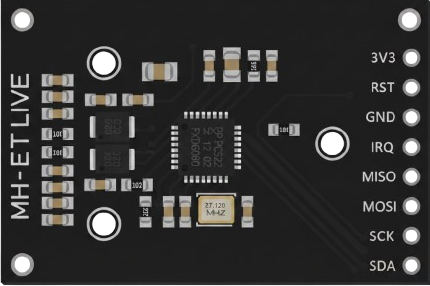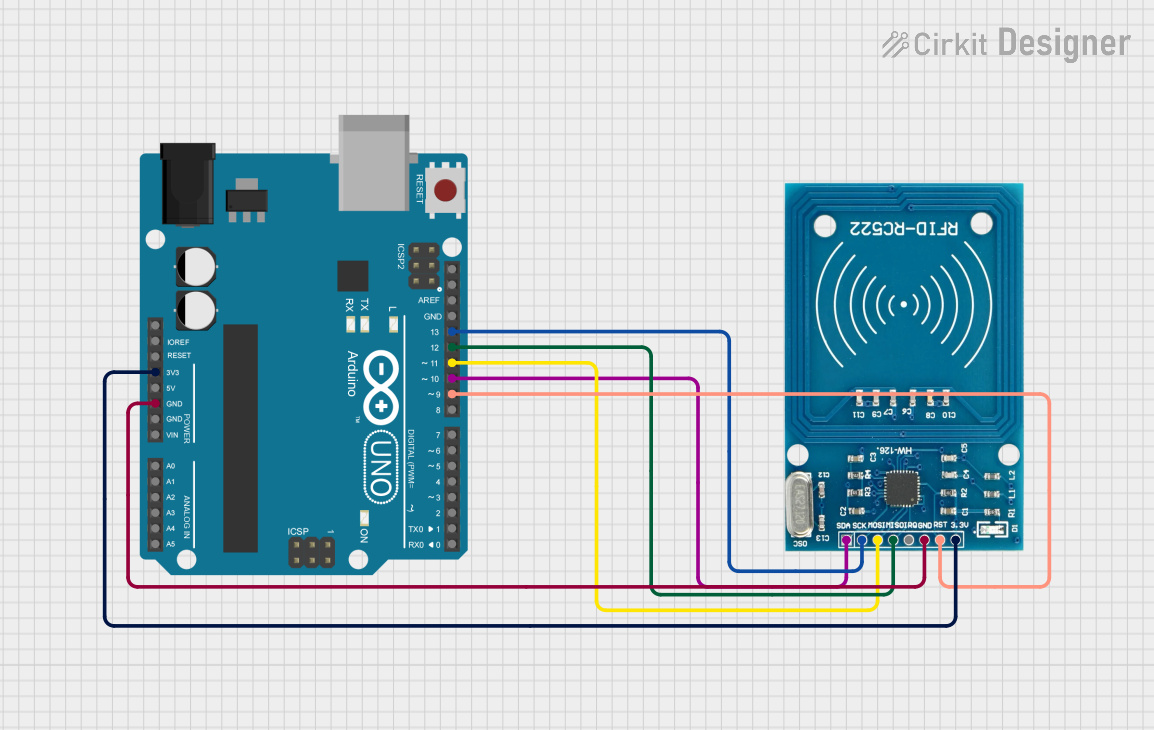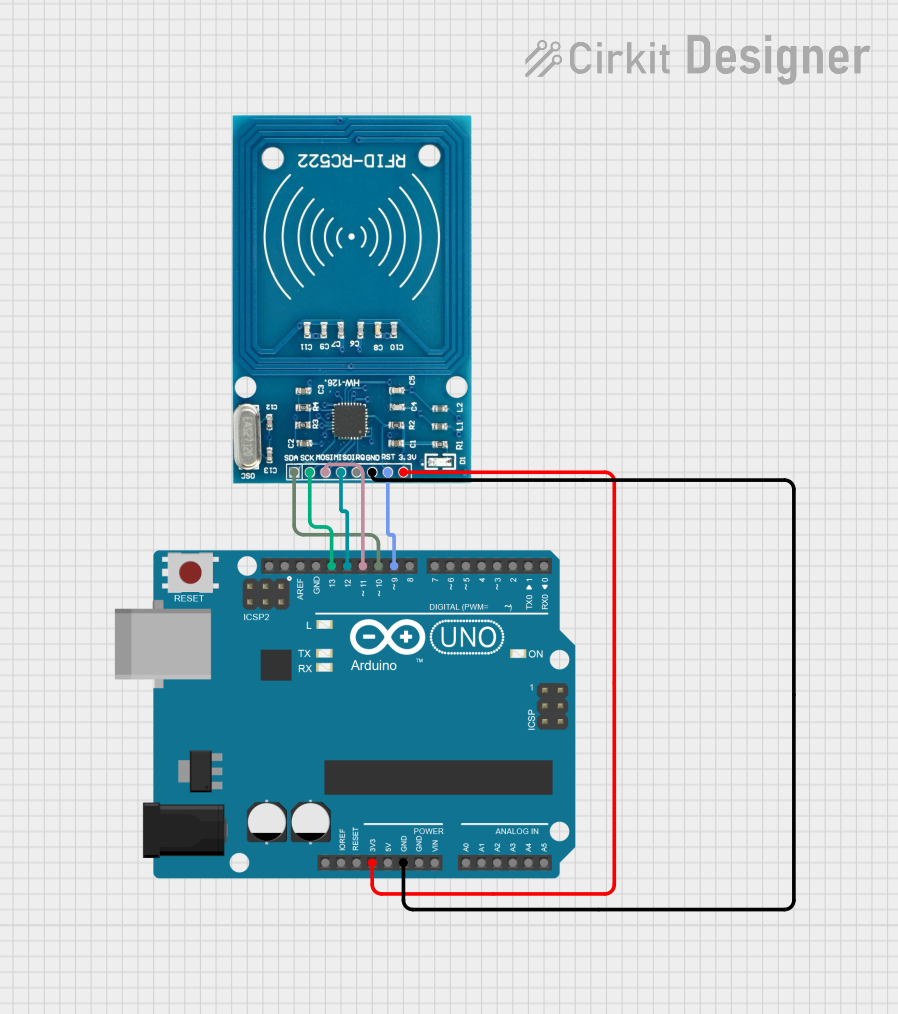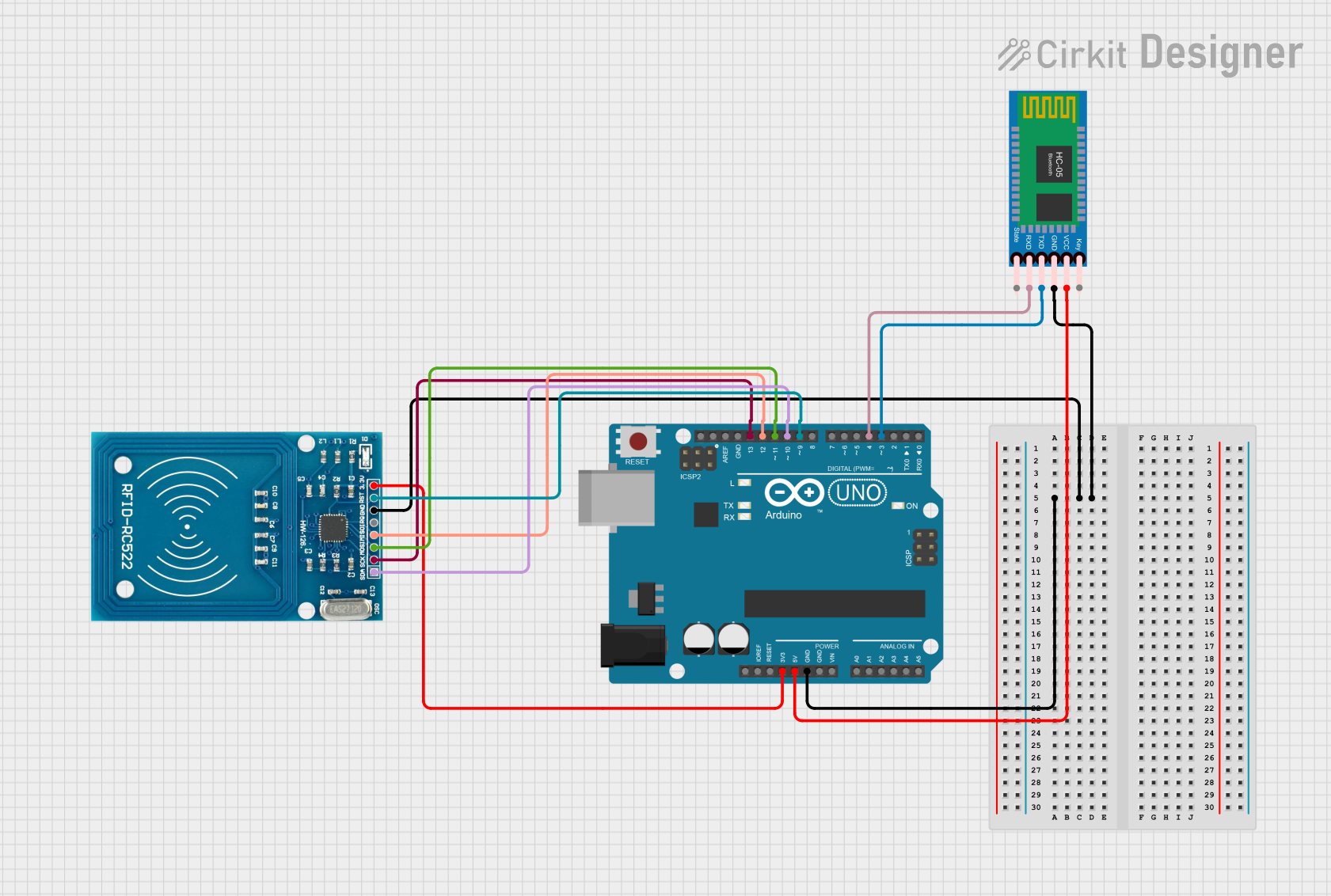
How to Use RFID RC522: Examples, Pinouts, and Specs

 Design with RFID RC522 in Cirkit Designer
Design with RFID RC522 in Cirkit DesignerIntroduction
The RFID RC522 is a low-cost RFID reader/writer module that operates at a frequency of 13.56 MHz. It is widely used for reading RFID tags and cards, enabling wireless communication in a variety of applications. This module is based on the MFRC522 IC and supports ISO/IEC 14443 Type A cards. Its compact size, low power consumption, and ease of integration make it a popular choice for projects involving access control, inventory management, attendance systems, and identification systems.
Explore Projects Built with RFID RC522

 Open Project in Cirkit Designer
Open Project in Cirkit Designer
 Open Project in Cirkit Designer
Open Project in Cirkit Designer
 Open Project in Cirkit Designer
Open Project in Cirkit Designer
 Open Project in Cirkit Designer
Open Project in Cirkit DesignerExplore Projects Built with RFID RC522

 Open Project in Cirkit Designer
Open Project in Cirkit Designer
 Open Project in Cirkit Designer
Open Project in Cirkit Designer
 Open Project in Cirkit Designer
Open Project in Cirkit Designer
 Open Project in Cirkit Designer
Open Project in Cirkit DesignerTechnical Specifications
Below are the key technical details and pin configuration of the RFID RC522 module:
Key Technical Details
- Operating Voltage: 2.5V to 3.3V (logic level), 5V compatible with level shifters
- Operating Frequency: 13.56 MHz
- Communication Interface: SPI, I2C, UART (default: SPI)
- Maximum Data Rate: 10 Mbps (SPI)
- Reading Distance: Up to 5 cm (depending on the tag and environment)
- Current Consumption: 13-26 mA (active mode), 10 µA (standby mode)
- Supported Protocols: ISO/IEC 14443 Type A
- Dimensions: 40mm x 60mm
Pin Configuration and Descriptions
The RFID RC522 module has 8 pins, as described in the table below:
| Pin | Name | Description |
|---|---|---|
| 1 | VCC | Power supply input (3.3V). Can be connected to 5V with a level shifter. |
| 2 | RST | Reset pin. Active LOW. Used to reset the module. |
| 3 | GND | Ground connection. |
| 4 | IRQ | Interrupt pin. Can be used to signal events (optional). |
| 5 | MISO/SCL/TX | SPI MISO (Master In Slave Out), I2C clock (SCL), or UART TX (default: SPI MISO). |
| 6 | MOSI/SDA/RX | SPI MOSI (Master Out Slave In), I2C data (SDA), or UART RX (default: SPI MOSI). |
| 7 | SCK | SPI clock input. |
| 8 | NSS/SDA | SPI chip select (NSS) or I2C address select (SDA). |
Usage Instructions
How to Use the RFID RC522 in a Circuit
- Power the Module: Connect the VCC pin to a 3.3V power source and the GND pin to ground.
- Connect to a Microcontroller: Use the SPI interface to connect the module to a microcontroller (e.g., Arduino UNO). The typical connections are:
- VCC → 3.3V
- GND → GND
- RST → Any digital pin (e.g., D9 on Arduino UNO)
- SCK → D13 (SPI clock)
- MOSI → D11 (SPI data out)
- MISO → D12 (SPI data in)
- NSS → D10 (SPI chip select)
- Install Required Libraries: For Arduino, install the "MFRC522" library from the Arduino Library Manager.
- Upload Code: Use the example code below to test the module.
Example Code for Arduino UNO
#include <SPI.h>
#include <MFRC522.h>
// Define pins for the RC522 module
#define RST_PIN 9 // Reset pin connected to D9
#define SS_PIN 10 // Slave Select pin connected to D10
MFRC522 rfid(SS_PIN, RST_PIN); // Create an instance of the MFRC522 class
void setup() {
Serial.begin(9600); // Initialize serial communication
SPI.begin(); // Initialize SPI bus
rfid.PCD_Init(); // Initialize the RC522 module
Serial.println("Place your RFID card near the reader...");
}
void loop() {
// Check if a new card is present
if (!rfid.PICC_IsNewCardPresent()) {
return; // Exit if no card is detected
}
// Check if the card can be read
if (!rfid.PICC_ReadCardSerial()) {
return; // Exit if the card cannot be read
}
// Print the UID of the card
Serial.print("Card UID: ");
for (byte i = 0; i < rfid.uid.size; i++) {
Serial.print(rfid.uid.uidByte[i], HEX); // Print each byte in hexadecimal
Serial.print(" ");
}
Serial.println();
// Halt the card to stop communication
rfid.PICC_HaltA();
}
Important Considerations and Best Practices
- Power Supply: Ensure the module is powered with 3.3V. If using a 5V microcontroller, use level shifters for the SPI pins.
- Reading Distance: The reading distance depends on the tag size and environmental factors. Avoid placing the module near metal objects.
- Library Compatibility: Use the latest version of the MFRC522 library for optimal performance.
- Interrupt Pin: The IRQ pin is optional and can be left unconnected if not used.
Troubleshooting and FAQs
Common Issues and Solutions
Module Not Responding:
- Check the wiring and ensure all connections are secure.
- Verify that the module is powered with 3.3V.
- Ensure the correct SPI pins are used on the microcontroller.
Card Not Detected:
- Ensure the card is within the reading range (up to 5 cm).
- Check for interference from nearby metal objects or other RFID devices.
UID Not Displayed:
- Verify that the MFRC522 library is installed and included in the code.
- Ensure the card is compatible with the ISO/IEC 14443 Type A standard.
FAQs
Can the RC522 module write data to RFID tags? Yes, the RC522 can write data to compatible RFID tags. Refer to the MFRC522 library examples for writing data.
Can I use the RC522 with a 5V microcontroller? Yes, but you must use level shifters for the SPI pins to avoid damaging the module.
What is the maximum range of the RC522 module? The maximum range is approximately 5 cm, depending on the tag and environmental conditions.